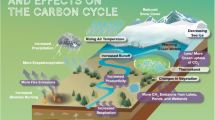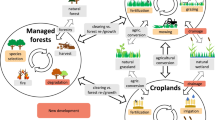Abstract
The impacts of the climate change predictions of four general circulation models (GFDL, GISS, OSU and UKMO) on net primary production (NPP) ofBetula pubescens, Fagus sylvatica and Quercus robur in The Netherlands were analysed using the process-based model FORGRO. FORGRO is a model suitable to simulate growth of managed mono-species stands. For the GCMs mentioned, both transient and equilibrium 2 × CO2 scenarios of temperature and precipitation change were evaluated and compared with responses under current climate. It was found that the NPP increases in the transient scenarios, but remains the same or declines in the 2 × CO2 scenarios. This is because respiration increases more with rising temperature than photosynthesis. During the transient scenarios this effect gradually increases, while in the 2 × CO2 scenario this effect is operating over the entire simulation period.
If water limitation is taken into account, then the NPP of the reference scenario is reduced. In both the transient and 2 × CO2 scenarios mis water limitation is annulated, resulting in a stronger response of NPP compared to the situation without water limitation. This enhancement of the response is most pronounced in the transient scenario due to the gradual effect of temperature on respiration.
Similar results were obtained with a version of FORGRO in which the photosynthesis module of HYBRID (PGEN) is incorporated, although the response in FORGRO-PGEN is usually higher than that of FORGRO. This is because the response of photosynthesis to CO2 rises with increasing temperature as defined in the PGEN-model, but not according to FORGRO.
Similar content being viewed by others
References
Farquhar, G. D. and von Caemmerer, S.: 1982, ‘Modelling of Photosynthetic Response to Environmental Conditions’, in Lange, O. L., Nobel, P. S., Osmond, C. B., and Ziegler, H. (eds.), Physiological Plant Ecology II: Water Relations and Carbon Assimilation 12B, Springer-Verlag, Berlin, pp. 549–587.
Friend, A. D.: 1991, ‘Use of a Model of Photosynthesis and Leaf Micro Environment to Predict Optimal Stomatal Conductance and Leaf Nitrogen Partitioning’, Plant, Cell and Environment 14, 895–905.
Friend, A. D.: 1993, ‘A Physiologically Based Gap Model of Forest Dynamics’, Ecology 74, 792–297.
Friend, A. D.: 1995, ‘PGEN: An Integrated Model of Leaf Photosynthesis, Transpiration, and Conductance’, Ecological Modelling 77, 233–255.
Goudriaan, J. and Unsworth M..: 1990, ‘Implications of Increasing Carbon Dioxide and Climate Change for Agricultural Productivity and Water Resources’, in Impact of Carbon Dioxide, Trace Gases, and Climate Change on Global Agriculture, ASA Special Publication 53, pp. 111–130.
Goudriaan, J.: 1993, ‘Interaction of Ocean and Biosphere in Their Transient Responses to Increasing Atmospheric CO2’, Vegetatio 104/105, 329–337.
Goudriaan, J. and Van Laar, H. H.: 1994, Modelling Potential Crop Growth Processes, Kluwer Academic Publishers, Dordrecht, 238 pp.
Hänninen, H.: 1990, ‘Modelling Bud Dormancy Release in Trees from Cool and Temperate Regions’, Acta Forestalia Fennica 231, 47 pp.
Kramer, K.: 1994a, ‘Selecting a Model to Predict the Onset of Growth of Fagus sylvatica’, Journal of Applied Ecology 31, 172–181.
Kramer, K.: 1994b, ‘A Modelling Analysis of the Effects of Climatic Warming on the Probability of Spring Frost Damage to Tree Species in The Netherlands and Germany’, Plant, Cell & Environment 17, 367–378.
Kramer, K.: 1995, ‘Modelling Comparison to Evaluate the Importance of Phenology for the Effects of Climate Change on Growth of Temperate- Zone Deciduous Trees’, Climate Research 5, 119–130.
Lauenroth W.: 1996, ‘Application of Patch Models to Examine Regional Sensitivity to Climate Change’, Climatic Change, 34, 155–160 (this issue).
Mohren, G. M. J.: 1987, ‘Simulation of Forest Growth, Applied to Douglas Fir Stands in The Netherlands’, Thesis, Agricultural University Wageningen, The Netherlands, 184 pp.
Mohren, G. M. J.: 1994., ‘Modelling Norway Spruce Growth in Relation to Site Conditions and Atmospheric CO2’ in Veroustraete, F. and Ceulemans, R. (eds.), Vegetation, Modelling and Climate Change Effects, SPB Academic Publishing bv. The Hague, The Netherlands, pp. 7–22.
Mohren, G. M. J., Bartelink, H. H., Jorritsma, I. T. M., and Kramer, K.: 1993, ‘AProcess-Based Growth Model (FORGRO) for Analysis of Forest Dynamics in Relation to Environmental Factors’, in Broekmeijer, M., Vos, W., and Koop, H. G. J. M. (eds.), Forest Reserves Workshop, Proceedings of a workshop held in Wageningen, 6–8 May 1992, pp. 273–279.
Richardson, C. W. and Wright, D. A.: 1984, ‘WGEN: A Model for Generating Daily Weather Variables’, U.S. Department for Agriculture, Agricultural Research Service, ARS-8, pp. 5–15.
Author information
Authors and Affiliations
Rights and permissions
About this article
Cite this article
Kramer, K., Mohren, G.M.J. Sensitivity of FORGRO to climatic change scenarios: A case study on Betula pubescens, Fagus sylvatica and Quercus robur in The Netherlands. Climatic Change 34, 231–237 (1996). https://doi.org/10.1007/BF00224634
Issue Date:
DOI: https://doi.org/10.1007/BF00224634




